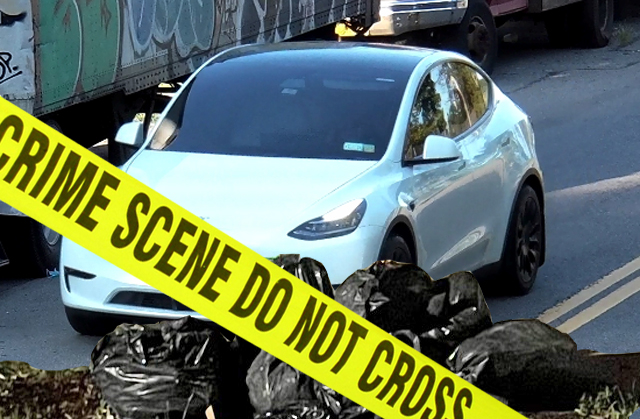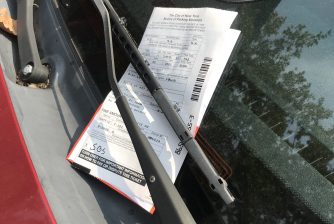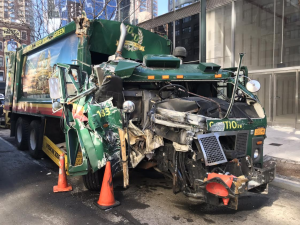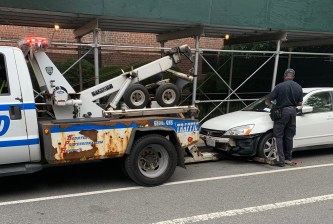Analysis: City is Much Better Seizing Cars from Illegal Dumpers than Reckless Drivers
The Sanitation Department steps up towing enforcement — but not the city's Dangerous Vehicle Abatement Program.

If only the Department of Transportation would start treating reckless drivers like garbage!
The Sanitation Department has this year seized far more cars belonging to people who illegally dumped trash or debris than the Sheriff has swiped from drivers who repeatedly drive recklessly. According to the DSNY, its small police force has seized 45 vehicles and issued 45 summonses (which start at $4,000), thanks to 42 surveillance cameras at known dumping sites in the five boroughs. The number of seizures and summonses is up from 18 vehicles and 19 summonses over the same period last year. (There are also 17 more pending dumping investigations, the department said.)
Meanwhile, the city has only taken six cars off the road this year under the Dangerous Vehicle Abatement Program, which allows the city to seize a car only after its owner has gotten at least 15 camera-issued speeding tickets or five red-light tickets within 12 months — and then failed to show up for a city-mandated safety course. (If the driver skips the course, he or she still gets another 45 days to complete the course before the agency sends the case to an administrative court for possible seizure of the car, the DOT told Streetsblog last year.)
Contrast that to the DSNY, which, working with elected officials, has placed cameras in areas known for illegal dumping — and sometimes moves them around.
“These illegal dumpers are not smart. They commit the same crime in the same locations over and over,” DSNY spokesman Vincent Gragnani said.
Once the cameras catch the cars’ images, then it’s relatively easy for the Sanitation cops to move in.
“We run the license plate, track it down, stake it out, and when someone enters the car, we move in, issue a summons, and impound the vehicle, which then cannot be retrieved until the summons is settled,” Gragnani said. “Our hope is that this enforcement is a deterrent.”
On the enforcement front, no agency does more than the Department of Transportation, whose 750 school zone speed cameras are now working 24-7-365. Just this year alone, roughly 3.7 million speeding tickets have been issued by the cameras, according to the city database.
That same database shows that 11,553 drivers have already hit the 15-ticket threshold this year alone, plus thousands more since the DOT began counting tickets against the program limits in late 2020. Yet as of Sept. 14, only 486 car owners have completed the safe-vehicle-operation course, with 980 getting notices. Eighteen more reckless drivers are scheduled to take the course by Oct. 16, and more respondents are in the pipeline, the agency said. Unlike the Sanitation cops, the city sheriff can only seize a car if the driver fails to take the course or takes the course and gets another ticket within six months.
It’s not apples to apples, but the fact remains: the garbagemen have grabbed more than seven times the number of malefactors’ cars off the street than the lawmen — a snapshot of the city’s priorities that seems straight out of the song “Alice’s Restaurant.” (One of the drivers who took a “safety” course, then reoffended, but continued driving because his car was never seized was traffic scofflaw Tyrik Mott, who should never have been on the road when he mowed down 3-month-old Apolline Mong-Guillemin on a Brooklyn sidewalk last year.)
You’re more likely to get towed if you don’t pay your tickets than if reach the Dangerous Vehicle Abatement Program threshold: The city resumed booting and towing in March 2021 on vehicles with more than $350 in unpaid tickets, and more recently has considerably stepped up enforcement of booting and towing of those who owe fines, the New York Post reported.
DSNY thinks that towing works — it has been publicizing its illegal-dumping drive (officially, still a pilot) in a series of hard-hitting tweets.
The camera doesn't lie. Our Enforcement teams recently caught another dumper #inQueens! They were caught on a camera sponsored by @CMBobHoldenNYC With the proof in hand, we impounded the car & issued a $4,000 summons. Don’t dump on your City. It makes a mess & will cost you.?? pic.twitter.com/3Bc642XHr5
— NYC Sanitation (@NYCSanitation) September 13, 2022
Of course, DSNY’s efforts to combat illegal dumping, like most city crackdowns — for example, the Adams administration’s recently announced push against “ghost cars” with fake paper plates — only respond to a small fraction of the problem: Thousands of New Yorkers complain about illegal dumping each year through the city’s 311 portal — which worsened substantially during the pandemic, when the city cut enforcement, according to a comprehensive series on our garbage issues that ran recently in Politico. There have been almost 20,000 complaints of illegal dumping so far this year, according to 311.
Lawbreakers who use their cars to dump illegally also might be using them for other lawbreaking. For example, we ran the plate of the Washington State-plated van that DSNY featured in the tweet below; the owner may have fraudulently registered it in that state, judging by the 11 violations totaling $1,308.13 the van accrued since March 2021 and a half in Brooklyn, suggesting that the owner lives here. The owner is a compound scofflaw: Four of those tickets totaling more than $558, including two for blocking a fire hydrant and one for speeding in a school zone, are “in judgment,” meaning that the city can tow the car.
These two drivers, one in #TheBronx and one #inBrooklyn, thought it was a regular night of breaking the law and dumping on our neighborhoods. NOPE – it was a sting operation by Sanitation Police, who seized both vehicles and issued three of the famous $4,000 summons. ??? pic.twitter.com/XQyAk2Qzcd
— NYC Sanitation (@NYCSanitation) July 26, 2022
Gragnani called the crime of illegal dumping “a theft of public space by private entities” whether those are contractors dumping construction and demolition debris on streets, sidewalks and vacant lots, instead of bringing it to a transfer station, as the law requires, or residences which for whatever reason — often, a home-improvement project involving construction — improperly dispose of waste. (The department collects as many as six bags or bundles per pick-up in front of homes.)
For DSNY, dumping enforcement is an equity issue, because the law-breakers target lower-income neighborhoods. Last year, it conducted enforcement blitzes in East New York in Brooklyn and Hunts Point in The Bronx, and since has installed cameras in those areas, which frequently see illegal dumping. The camera locations are secrets.
“Our goal here is not just to clean these streets, sidewalks and lots but to stop these dumpers before they steal our public space,” Gragnani said. “It’s a quality-of-life issue for all residents of affected neighborhoods, including pedestrians and cyclists.”



